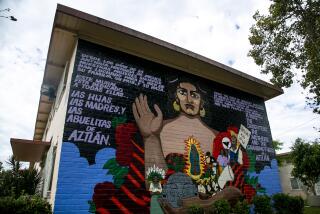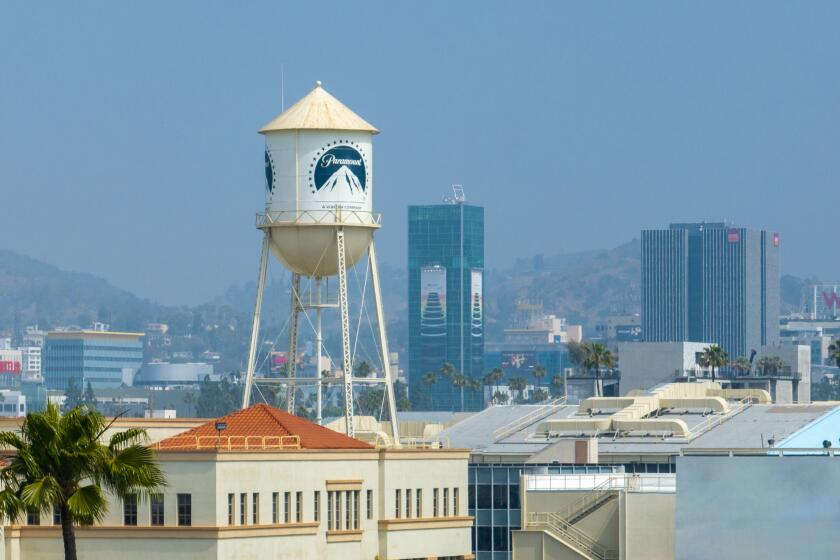ART : A Wider Sense of History : The pioneering work of Shifra Goldman has helped bring overdue scholarly recognition to modern Latin American art. But at 69, she finds that her mission is far from over.
- Share via
SAN DIEGO — “I don’t want to be the grande dame of anything, God forbid,” Shifra Goldman bristles, recalling how she was described in a review of her recent book, “Dimensions of the Americas: Art and Social Change in Latin America and the United States.” The word “distinguished” before her name also makes her uncomfortable, she says, but she warms to the term “pioneer.” It better suits her temperament and accomplishments, catching the spirit of her groundbreaking scholarship in the fields of Chicano and modern Latin American art.
Goldman, startlingly youthful at 69, is down-to-earth, friendly but focused, a perfectionist who occasionally spells names out loud to ensure accuracy on a note-taker’s part. Over lunch recently, talking through a cold, she showed some of the same determination and confidence she draws upon in her professional battles.
For nearly 30 years, Goldman has struggled to win recognition for art and artists overlooked by the shapers of art history--the professors, curators and critics trained, for the most part, within a Eurocentric, formalist tradition. Through her teaching at several Los Angeles area colleges and her prolific writing and lecturing, Goldman has fervently practiced the “new” art history, a discipline that emphasizes context over connoisseurship, asserting a tight bond between the making of art and political, economic, social and historical phenomena.
The revolution in art history has brought greater visibility to art by Latin Americans, Goldman says through the steam of a large bowl of cocido (the meat and vegetable soup that doubles as Mexican penicillin), PHRASING? but universities have been slower to catch on. They have “patched and plugged” to satisfy student demands, she says, but they have taken no leadership. Why?
“There’s a whole string of adjectives I could use,” she answers, paraphrasing the detractors: “ ‘Latin American art is imitative, it’s not avant-garde, it’s mimetic, it’s too political, it’s really not world-class. Therefore, why bother?’ ”
It’s not just a problem of the academy either. Alma Ruiz, exhibitions coordinator for the Museum of Contemporary Art in Los Angeles, champions Goldman’s perspective and agrees that such issues have placed Latin American art at a disadvantage in America’s public collections.
“Who are Latin Americans?” she asks. “A mixture of at least two peoples, one of them European. So why shouldn’t art that comes from that part of the world be considered alongside European art?
“Why is it that when someone like Mark Rothko or Willem de Kooning immigrates to America, he’s heralded as an American artist, but when an artist from Latin America comes, he’s always considered Latin American, no matter how long he’s been outside of his native country?”
Goldman calls herself a skeptic--”maybe a borderline cynic”--but she’s encouraged by recent developments that suggest a growing awareness of Latin America’s contribution to modernism. Last year, the Getty Center for the History of Art and the Humanities appointed a curator specifically to expand the scope of its resource collections to include Latin America. And just a few months ago, MOCA announced a new, long-term consortium with the Museum of Modern Art in New York and the Art Institute of Chicago to organize exhibitions and educational programs focused on Latin America.
One of the goals, Ruiz says, who spearheads the program for MOCA, “is to bring that part of the world into the international art critical dialogue.”
Integrating Latin American art with the history of modernism as it is conventionally taught and presented has been Goldman’s professional raison d’e^tre. Born in New York of Russian Jewish parents (her father a waiter, her mother a seamstress), Goldman spoke only Yiddish until the age of 6. After being steeped in the cultural riches of New York and graduating from the High School of Music and Art, she moved--”to my great horror and dismay”--with her family to Los Angeles, where she suffered severe withdrawal from art museums and foreign films.
“Bored to tears,” she started college in the late ‘40s at UCLA. While there, she became active in civil rights causes, such as defending black students who came to the campus under the GI Bill and were refused haircuts by Westwood barbers. Interrupting her studies, she served for several years as “the youngest, most naive, most unknowing member” of the Civil Rights Congress of Los Angeles, and then left the job to have a child in 1953. MARRIED WHEN PREGNANT? NOT CLEAR Though her marriage to a Chicano (“only then we didn’t have such a word; he was Mexican American”) dissolved when her son was just a baby, the relationship left her with a fluent command of Spanish.
After a long string of unchallenging, rent-paying jobs, Goldman returned to school in her mid-30s, studying art history at Cal State L.A. After getting her master’s there, she began work on her doctorate at UCLA, and in 1971 she started teaching full time at Rancho Santiago College in Santa Ana.
F rom the outset, Goldman was breaking new ground. “I had no colleagues, no chain, no links--I had nothing,” she remembers. She had to wait three years to start her dissertation, she says, because none of the faculty at UCLA would oversee her research on a modern Latin American subject. Finally, a new professor came on board--his area of expertise was 19th century French Symbolism, but he agreed to advise her--and in 1977 she was granted the doctorate. Her thesis was published in 1981 under the title “Contemporary Mexican Painting in a Time of Change.”
The year 1977 marked another turning point in the field: Sotheby’s held its first auction of modern Mexican art, and it was a success. The next year, a spate of Mexican-themed exhibitions appeared, underwritten by U.S. institutions for the purpose, Goldman believes, of softening public opinion on an oil and natural gas agreement between Mexico and the United States.
“The cultural masquerade went on,” Goldman says, “in which Mexican art suddenly became a big item across the country.”
More blockbusters have followed, such as “Hispanic Art in the United States” WHERE TK and “The Latin American Spirit,” which traveled to San Diego FROM? in 1989. While these shows have brought a great deal of attention to Latin American art, some come burdened with political baggage. For instance, “Mexico: Splendors of Thirty Centuries,” which toured the United States in 1990-91, AND WAS WHERE IN L.A.? was successfully exploited, Goldman believes, to add gloss to the campaign for the North American Free Trade Agreement.
All of this is well-documented in Goldman’s book “Dimensions of the Americas,” which includes 20 years of her writings on Chicano and Latin American art. In it, she traces the evolution of the field of Latin American art history as well as her own personal journey toward becoming an “activist art historian,” giving voice and visibility to those left out of the loop.
Since retiring from full-time teaching in 1992--the same year she won the prestigious Frank Jewett Mather Award for Distinction in Art Criticism from the College Art Assn.--Goldman has been on “permanent sabbatical.” She teaches part time at UCLA (where she has also been a research associate at the Latin American Center since 1981), lectures in Guatemala, Mexico, Costa Rica and beyond, and generates a steady stream of articles and reviews. Her next book, “Chicano Art: Continuities and Changes,” coauthored with Tomas Ybarra-Frausto, will appear late next year or in early 1997.
Goldman rarely answers questions with short, pat answers. Her writings, like her conversation, are provocative, full of tough questions and solid information. They make a persuasive case for her pioneering role in the field of art history, but having the first word on many of the subjects she has covered doesn’t mean she wants to have the last.
“These are points of departure, and that’s good,” she says. “Now it’s up to new people to reaffirm, to change, to reconstruct. Suits me fine.”
*
“DIMENSIONS OF THE AMERICAS: Art and Social Change in Latin America and the United States,” University of Chicago Press. Publication Date: 1994. Price: $29.95 paperback.
More to Read
The biggest entertainment stories
Get our big stories about Hollywood, film, television, music, arts, culture and more right in your inbox as soon as they publish.
You may occasionally receive promotional content from the Los Angeles Times.










